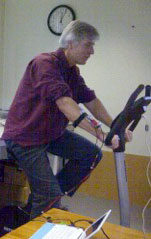Contacts: Dr. Christof Schwiening, Department of Physiology, Development and Neuroscience and Brian Corbett, Cambridge Enterprise International Outreach
Mentors: Tom Copeland & Andrew Chapman, 42Technology

Assessing fitness, during a period of athletic training, is surprisingly difficult. Whilst racing performance or maximal effort tests can indicate improvements in fitness, they are not always possible. Maximal effort during training is troublesome – circumstances or fatigue may not allow it, and it may be undesirable as there is often a need for recovery which interferes with further training. Indeed, there are surprisingly few techniques to assess training progression beyond the simple measurement of heart rate during a challenge. In assessing fitness for an endurance athlete one of the key physiological variables often measured is VO2max. This is the maximum rate at which an individual can take-up oxygen: the more oxygen taken up, the higher the sustainable power they can produce. However, VO2max tests require maximal effort which, as for racing performance, is often problematic during training. Furthermore, VO2max tests are difficult to perform since they require costly equipment, a high degree of motivation and are singularly unpleasant!
The rise in oxygen consumption during exercise is coupled to heat production which warms the athlete and results in sweating. Whilst sweating is often considered to be highly variable or to depend on sex, this does not appear to be the case. Dr Schwiening and colleagues have shown that the relationship between body temperature and sweating can be a simple function of VO2max at a range of different sub-maximal exercise intensities (Schwiening et al., 2011; Absolute power, not sex, promotes perspiration). Individuals with high VO2max have the ability to produce large amounts of both heat and sweat whilst staying relatively cool. Individuals with low VO2max produce little heat or sweat but, if the exercise continues for long enough, get very warm. The result of this relationship between VO2max, body temperature and sweating is that it is possible to use an exercise challenge that does not require an all-out effort (a “sub-maximal” challenge), together with the measurement of sweating rates and body temperature to provide a good estimate of VO2max. Since the exercise can be relatively low intensity and the measurement of sweating and temperature is cheap and simple, this test can be used to assess fitness in a wide range of situations where standard VO2max testing is not possible. The sweating-based test can be performed by the very young or old and by those who would struggle to produce a maximal effort (hospital patients, fatigued athletes etc).
The sub-maximal nature of the test, and the fact that it relies on thermoregulation and not athletic performance, may also prove to make the test attractive to those engaged on health-based exercise who have no interest in competition or maximal performance per se.
Since the test is a measurement of thermoregulatory fitness (but expressed in terms of VO2max) it has a range of other uses beyond its use in sports. It may provide a useful measurement of thermoregulatory capacity in individuals exposed to heat stress – those wearing protective equipment (e.g. factory workers, military, firemen) and those who take medications or drugs that impair sweating or responses to heating.
By focussing on a physiological limit to exercise performance – heating – it may be of interest to high level athletes who are already familiar with many of the other training tools (heart rate monitors, lactate measurements, hypoxic tents etc) and are looking for ‘an edge’ to optimize their performance. Within high level clubs there is remarkable little focus on thermoregulatory fitness despite the knowledge that body temperature rises, even in cool conditions, impede athletic performance.
The challenge for the i-Team is to look at this new test for thermoregulatory fitness and investigate the whole range of possible uses for it. By talking to possible users and purchasers of this device, they will need to analyse and recommend the best short-term and long-term markets for the researchers as they seek to commercialise their invention.
